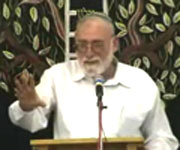Beit Midrash
- Mishna and Talmud
- Talmud - Gemara
- Various Shiurim
- Jewish Laws and Thoughts
- Torah Study
- Ways of Study
The Torah study is dedicatedin the memory of
Rabbi Meir b"r Yechezkel Shraga
In this lesson Rav David Samson will be focusing on introducing the learning of Gemmarah to those who are just beginning to become familiar with it. The lesson will teach the teacher basic learning techniques and different approaches that will produce the best results without overwhelming the student. It will also concentrate on how to prepare the ideal lesson, using the Rishonim as source material. In the end, Rav Samson will encourage the idea of self learning.
Learning Methods and Basic Teaching Techniques
The goal of the teacher is to encourage the student to enter the world of learning Gemmarah, with the hope that he will know how to learn and love learning. These two goals will only occur when the student understands the value of his learning and feels that he is progressing in his studies.
We will look at a couple of basic points:
1) Rav Chaim from Brisk had a special method of learning that was based upon the sharp conjecture that something which seems singular in nature is actually two separate things. From this he would further extrapolate different halachot. This method intensifies the learning process. Instead of learning the Gemmarah the student will learn Rambam which may contradict the Gemmarah, whereupon Rav Chaim will explain the contradiction. The Rosh Hashiva will then further question Rav Chaim's solution to the contradiction using the source material of the Shita Mikubetzet and may further divide the concepts with his own methodology (for example this is a din b'chevza and this is a din b'gavra).
The Natziv had a different way of learning Gemmarah which was based upon clarification of the Rishonim method and is explained simply in his book the "Haemek Shela". The Natziv used precise language to clarify if, indeed, this was what the specific Rishon wanted to convey to us. This method is being continued by Yeshivat Mercaz Harav, as prescribed by Rav Tzvi Yehuda Kook zt"l. Rav Kook instructed that one should learn the methodology of the Rishonim and the principle points of the Achronim and then see how they both intertwine and at what point they complete each other.
2) How should one not teach? At times a teacher wishes to learn in a fundamental fashion, and asks all possible questions and any Din that is connected to the subject. Does this make sense? Is the source from the Torah-Dereita, Drabbanan, Dvrei Sofrim, Pirush Mikubal, Halacha from Moshe MeSinai Gzira, Saig, Takana or even Minhag? Do we learn it from a verse? Is it a Takana? And if it is why was it necessary to implant it? Is it Gzira that spread out? Who? When? Where? Is it accepted only in Eretz Yisrael or also outside of Israel? Is the law only performed at the time of the Beit haMikdash? Is it only temporary or is it for all generations? Is it only performed by the Cohanim, woman, or only Bnei Noach? Is this a mitzvah that is connected to time? Is it Chefza, or Gvrah? And so, this is the way in which he might teach. Although this seems like an exaggerated way to teach students, it can serve as a tool to help to us understand how not to teach. (to prepare a lesson on something that we do not desire to teach.)
3) The teacher needs to differentiate between questions, contradictions and opposing methods and to fully clarify to the student the Talmudic concepts along with all the above. He needs repeat and review all these concepts until they are thoroughly understood and clear to the student, as they are the basis of learning Gemmarah.
4) In order to teach Tosafot one needs to clarify its structure. The Tosafot is broken up into two parts. The first part involves a question, an explanation and three proofs. The second part consists of two proofs and one more unacceptable proof. Thus, the student realizes exactly what he does not understand, which the first step towards understanding is. If the student does not know how to get through this first stage then it will be difficult for him to figure out exactly what he doesn't understand and it will not be easy for him to learn the Gemmarah. However, if the structure of Tosafot is clear to the student and he is able to define to himself which point in the Gemmarrah needs clarification, then that point that he is missing should not detract from understanding that Gemmarah as a whole. The student will then be on his way to understanding what he is not grasping and will be better able to learn Gemmarrah .
5) It is essential that the student sees the big picture in order to connect the small details to the larger concepts. For example when examining the concept "a women is bought by three means" it is important to precede the learning with discussions of the family unite and seder nashim.
Preparation for the Lesson
The ideal preparation for a lesson is long and tedious. The first stage is to examine every book that deals with the subject. To start with Otzer Poskim and to leave no stone unturned whether it be seemingly very important or less important. In the second stage, one needs to categorize the material. The third stage integrates all the material into one organized system. The last stage involves focusing on the specifics of the subject. The lesson will than encompass all the methods of the Rishonim.
Anything Added Only Detracts
Occasionally there may be eight different Rishonim methods, but it is possible to reduce them into two general directions. At other times the opposite occurs when the Tosofot and the Rosh basically say the same thing, but a slight difference is found between the two methods which presents two opinions. One should, therefore, be diligent and aware in order to notice any changes in the language of the text. This style of learning is usually applicable to students that are on a higher level. At the early stages of learning Gemmarah the student needs to differentiate between two completely different methodologies and only at a later stage will the student be able to detect that there is the possibility of breaking down a single method into two separate ones. This way of teaching is appropriate for both high school yeshivas and higher level yeshivas because once you have broken down the sugia and brought down four explanations of the Rishonim, you have exhausted the students and have maybe lost them in the process.
It is possible for the student to make specific differentiations only after he is at a level where he himself has mastered the four methodologies explaining a sugia. One would then only need to remind the student of these methodologies within the first ten minutes of the lesson, while the remaining time would be devoted to expounding on the detailed differences between them. Students would not tire, as there would be no more than two lessons on the subject. In short students can only listen to one subject for a specific period of time before they begin to lose interest or begin to themselves feel lost.
After the main methods have been categorized, central questions pertaining to each method should then be classified (questions that are presented by the Rishonim, the Achronim and even the teachers own questions). The teacher should then write why each method does not agree with the others and why each one chooses has its own unique way of presenting and providing questions and answers. Once this is written you have completed the lesson.
Self Learning and Actively Involving the Students
Self learning is very important because it is the basis of learning. The purpose of a lesson is for the teacher to direct and teach the student how to study the material on his own. If the student receives all the material and information from his teacher he will find it difficult to develop and to later learn well by himself. Most students are taught by this low level type of teaching method, which doesn't properly motivate or actively involve them. On the contrary, the student usually doesn't do anything but listen and listen. A higher level of teaching, called translation, allows the student to understand what he has learned by repeating in his own words what he has been taught. This usually does not happen during a lesson, but it is possible if the teacher properly gears the lesson to involve the students. This method, however does pose a problem in that the teacher is usually able to actively involve the stronger students and the weaker ones often remain on the side. A solution to this problem is to divide the class into separate groups. The teacher walks among them supervising their progress and assigning to them appropriate work or projects.
A large part of the self learning involves learning from worksheets. There are two types of worksheets: one that prepares the student before the lesson and one that recounts the material that was presented during the lesson. Homework and learning with a chevruta are also important for preparation, for involving the student, and for reviewing the lesson.
How does one prepare a worksheet? By explaining the sources and asking: What are the three questions? What are the four explanations? Why do the different methods disagree with each other? What is brought forth from sugia to halacha, and what is the nafka mina between the methods?

Temporary Townsmen and Walled-City Dwellers on Purim
Rabbi Chaim Katz | Adar 2 5768
A Spiritual Introduction to Seder Nezikim (Order of Damages)
Rabbi Zalman Baruch Melamed | Cheshvan 5762
When Faced with Inevitable Transgression
Rabbi Zalman Baruch Melamed | 5766






















